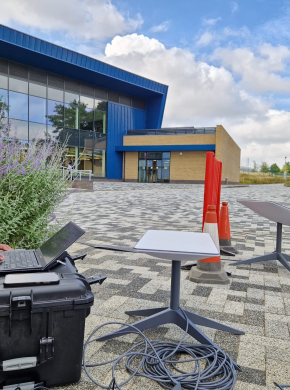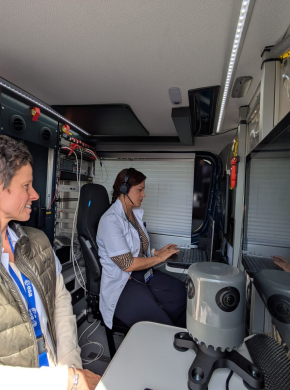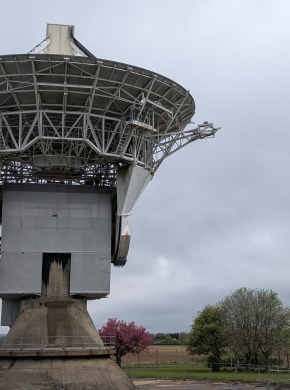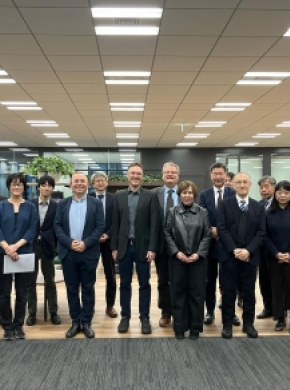NTN Forum activities are developed within the Work Groups.
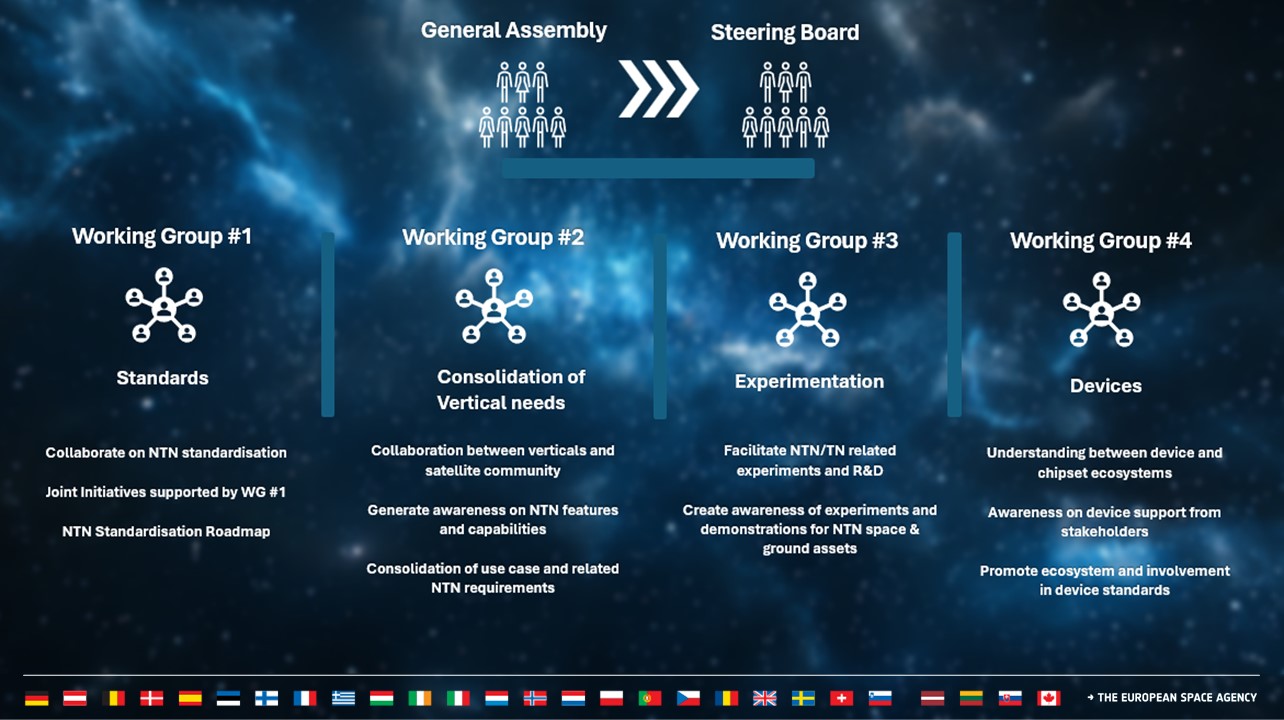
NTN Work Groups (WGs)
The four NTN Forum Work Groups are:
- WG 1: Standardisation Interest Group (SI)
- WG 2: Consolidation of Vertical Needs
- WG 3: Experimentation
- WG 4: Devices
Registered NTN Forum participants will be invited within a month of their registration to join the NTN Forum Team in a Microsoft Teams environment.
Within the NTN Forum, participants will have access to all Work Groups and will be able to set their own notification preferences to reflect what better suits their interest.
WG 1: Standardisation Interest (SI)
WG 1 is a platform through which a broad range of stakeholders discuss ongoing and planned 3GPP NTN standardisation topics by outlining outcomes/plans of relevant 3GPP working groups and by coordinating joint contributions as appropriate. Work towards other standardisation groups is included as/if applicable to 5G/6G NTN.
Its objectives are, but not limited to:
- Improved mutual understanding and collaboration
- Joint initiatives supported by multiple SI WG participants
- Sense of unity among SI WG members in the 3GPP arena
- An NTN standardisation roadmap
WG 1 Co-Chairs
 |
 |
| Nicolas Chuberre | Xavier Pons Masbernat |
| TAS-F | Airbus |
| nicolasDOTchuberreATthalesDOTaleniaspaceDOTcom |
xavierDOTponsmasbernatATairbusDOTcom |
WG 2: Consolidation of Vertical Needs
WG 2 serves as a platform for a broad range of stakeholders to discuss and exchange information about the verticals’ use cases and supported by: NTN and their corresponding requirements; the main challenges or barriers faced by verticals for satellite adoption and how the satellite community can answer these needs from various verticals overall in a standardised approach that integrates satellite as part of 5G and upcoming 6G. The time frames will also be identified.
Its objectives are:
- Improved mutual understanding and collaboration between the verticals and the satellite community;
- To create an awareness about the status of the standards related to NTN and how it can provide suggestions to the verticals;
- Facilitate interaction and discussions on satellite NTN topics that are important for verticals;
- Identify and action potential joint initiatives supported by multiple verticals
- Create white paper(s) consolidating verticals use cases and requirements related to satellite;
- Provide inputs to WG 1 when needed;
- Coordinate and exchange with WG 4 when needed.
WG 2 Co-Chairs
 |
 |
 |
| Thierry Berisot | Maria Guta | Luca Lodigiani |
| Novamint | ESA | Aalyria |
| tberisotATnovamintDOTcom | mariaDOTgutaATesaDOTint | lucaATaalyriaDOTcom |
WG 3: Experimentation
WG 3 serves as a platform for a broad range of stakeholders, to exchange insights and information on NTN/TN-related experimentation activities for the integration/ unification of NTN within the evolving 3GPP ecosystem to promote mutual understanding and effectiveness in pursuit of the vision (Applicability of the experimentation related activities to integrated satellite, High Altitude Platforms (HAPs) and UAVs multi-layer network are also considered. The WG 3 can also provide a platform/forum to garner support from individual participating organisations for specific actions they wish to pursue by:
- Facilitating interaction and discussions between NTN/TN experimentations groups;
- Facilitating interaction and discussions between NTN-focused research and development activities;
- Creating an awareness about test, experimentations and demonstration opportunities for NTN ground, space assets and services.
Experimentation spans from laboratory testbeds and small scale proof of concepts to large scale service platforms that aim to validate system concepts and services of NTN/TN integrated system and networks. This includes over-the-air tests; verticals specific to technology; and specific simulators and emulators to verify the performance of technology features and algorithms. The scope encompasses space, ground and networking domains, RF and optical access ISL technology.
In particular, WG 3 addresses:
- Experimentation platforms;
- Technology experimentation mainly 3GPP NTN access and transport, Multi-RAT, Multi-orbit NTN, NTN space-specific technology, including but not limited to, onboard processors’ onboard edge computing/ MEC, NTN devices, cloud technology necessary for the integration of NTN/TN with cloud infrastructure, vertical-specific technologies required for vertical-specific NTN experimentation;
- Several transversal themes necessary for NTN/TN network and services management and operations, service offerings, including but not limited to:
- AI/ML in several areas spanning from radio resources and interference management; networks and services management and NTN/TN topology management. This calls for high-fidelity simulation/emulation testbeds, live NTN/TN network probes, and telemetry from in-orbit tests to generate training data for AI/ML algorithms performance and complexity/cost assessment;
- Spectrum sharing - as spectrum demands increase for wireless systems this calls for investigation, experimentation and validation of spectrum reuse and sharing techniques;
- Service and operational NTN/TN integration calls for experimentation and validation of new networking solutions, such as routing, VNF placement and core network components placement.
- Experimentation collaborations – such as at national, regional and international level, and with vertical representatives (NTN members are from six continents and 184 organisations) as well as national and international experimental facilities (data as of Dec 2024). Collaboration is open with terrestrial platforms, such as SNS-JU platforms, other national platforms and from overseas entities of the NTN Forum;
- Experimentation challenges resulting from prioritisation of techniques and technologies experimentation within the WG 3 and exploration of experimentation collaborations. Prioritisation will be associated with timeline proposals;
- Elaboration of technical explainers and recommendations with a focus on technical implementation and experimentation.
WG 3 Co-Chairs
 |
 |
 |
|
| Maria Guta | Munira Jaffar | Alexander Hofmann | |
| ESA | Echostar | Fraunhofer IIS | |
| mariaDOTgutaATesaDOTint | muniraDOTjaffarATechostarDOTcom | alexanderDOThoffmannATfraunhoferDASHiisDOTde | |
 |
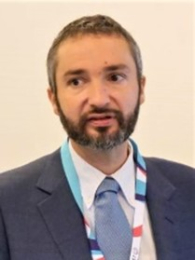 |
 |
 |
| Florian Voelk | Stefano Cioni | Guary Acar | Luca Lodigiani |
| University Bundeswehr | ESA | ESA | Aalyria |
| florianDOTvoelkATunibwDOTde | stefanoDOTcioniATesaDOTint | guaryDOTacarATesaDOTint | lucaATaalyriaDOTcom |
WG 4 Devices
The WG 4 is a platform through which a broad range of stakeholders discuss and exchange information about the different aspects related to devices with NTN support.
The types of devices considered will, at least, be the following for all types of satellite deployments:
- Internet of Things (IoT) devices;
- Redcap devices;
- Smartphones with NR NTN as well as IoT NTN;
- VSAT (mobile and fixed);
- Broadcast receiver devices supporting NR NTN.
Its objectives are, but not limited to;
- Improved mutual understanding and collaboration between the device ecosystem (device and chipset) and the satellite community;
- Create an awareness about the needs in terms of device support from satellite stakeholders and the associated end users including verticals;
- Promote the development of device ecosystems for each category of device supporting different satellite deployments (GSO, NGSO, multi-orbit);
- Promote the involvement of all players in the device related standard and industry initiatives such as 3GPP but as well GSMA TSG, GCF, DM for the benefits of the whole ecosystem;
- Provide inputs to WG 1 when needed;
- Coordination/exchange with WG 2 when needed.
WG 4 Co-Chairs
 |
 |
|
| Thierry Berisot | Xavier Pons Masbernat | Ilias Panagiotopoulos |
| Novamint | Airbus | ESA |
| tberisotATnovamintDOTcom | xavierDOTponsmasbernatATairbusDOTcom | iliasDOTpanagiotopoulosATesaDOTint |

NEWS AND EVENTS
ESA, Eutelsat, Airbus, MediaTek and partners successfully T…
The innovative 5G protocol, introducing Conditional Handover, allows satellites in low Earth orbit (LEO) to provide reliable connectivity whilst switching between ground and satellite infrastructures, advancing the integration…
ESA and the Bharat 6G Alliance collaborate to develop next-generation satellite-enabled 6G networks
The two organisations have signed a Memorandum of Intent (MoI) to collaborate on developing integrated 6G terrestrial and satellite networks.
Direct-to-device connectivity from space and why we need it: ESA releases new white paper
ESA’s Connectivity and Secure Communications has released a new white paper – published under the Space for 5G/6G and Sustainable Connectivity programme of ESA’s Advanced Research in Telecommunications Systems (ARTES) – that explores how European…
ESA and SNS JU 6G-SANDBOX join forces to pioneer large-scale non-terrestrial network trials
A set of large-scale non-terrestrial networks (NTNs) trials aiming to showcase the vast utility of space-based 5G and 6G communications are set to be conducted across Europe as a part of the European Commission’s SNS JU 6G-SANDBOX project. ESA's…
ESA’s Connectivity and Secure Communications releases new white paper on ho…
The paper – titled “Converging Earth and Space: Advancing Automotive” and featuring research conducted under the Space for 5G/6G and Sustainable Connectivity programme of the European Space Agency's (ESA) Advanced Research in Telecommunications…
New platform for reliable connectivity developed in partnership with ESA’s 5G/6G Hub
From the European Space Agency's (ESA) European Centre for Space Applications and Telecommunications (ECSAT)’s 5G/6G Hub, British company UniVirtua has successfully demonstrated a new product called dashAlpha – a connectivity-enhancing…
ESA and Singapore University of Technology and Design tighten cooperation to advance 5G…
ESA's Connectivity and Secure Communications and the Future Communications Research and Development Programme (FCP) at the Singapore University of Technology and Design (SUTD) have formalised a tighter research…
ESA-supported LIDE mission takes to orbit to demonstrate new technique for global 5G connectivity
A new CubeSat developed with support from the European Space Agency (ESA) has made it to orbit as a part of the Direct Access Live Demonstration (LIDE) mission. Aiming to test the feasibility and demonstrate establishing a stable 5G connection…
ESA and Nokia demonstrate AI-powered telemedicine over integrated satellite 5G network
As part of a telemedicine demonstration, European Space Agency (ESA) teams based at the European Centre for Space Applications and Telecommunications (ECSAT) in Harwell, UK, and the European Space Research and Technology Centre (ESTEC) in…
ESA, Telesat and RAL Space successfully demonstrate Q-Band satellite link over low Earth orbit
ESA, Telesat and the Science and Technology Facilities Council’s (STFC) RAL Space have reported a groundbreaking milestone in telecommunications technology, successfully establishing a Q-Band (38-39 GHz) link over LEO, between the RAL Space…
How ESA is enabling AI adoption in telecommunications
A strategic vision for the future of telecommunications, where Artificial Intelligence (AI) serves as the cornerstone of next-generation networks, has been presented in a new whitepaper released by the European Space Agency’s (ESA) Space for 5G/…
ESA drives European and Japanese Partnerships for 5G/6G technological collaboration
The European Space Agency (ESA) and the National Institute of Information and Communications Technology (NICT) of Japan met at the NICT Innovation Center in Tokyo on 31 March. The meeting discussed the key results of trials resulting from the ESA…








